Lesson
2
A New Deal and a New War
|
|
|
|
Timeline |
|
| 1919 |
|
| Custer State Park set up |
|
| 1921 |
|
| State cement plant started |
|
| 1929 |
|
| Stock Market crashed |
|
| 1932 |
|
| Franklin Roosevelt became
president |
|
| 1941 |
|
| Japanese bombed Pearl
Harbor |
|
| 1950 |
|
| Korean War began |
|
| 1955 |
|
| Captain 11 show opened |
|
| 1956 |
|
| Interstate highways
started |
|
| 1966 |
|
| Missouri River dams
completed |
|
| 1972 |
|
| George McGovern ran for
president |
|
| 1973 |
|
| AIM took over Wounded Knee |
|
| Eros Data Center opened |
|
| 1989 |
|
| South Dakota celebrated
100 years |
|
| 1996 |
|
| Captain 11 show closed |
|
| 2001 |
|
| State cement plant sold |
|
| Homestake Mining Company
closed |
|
|
People across
the United States needed work. When Franklin D. Roosevelt was
elected president, he knew he had to do something. The year was
1932. He set up federal programs to help. He called them the
"New Deal." These programs put people back to work; helped
them feed their families; made business and industry stronger; and
helped farmers farm better. People called them "federal
relief." These programs were important in South Dakota. Within
two years, almost forty percent of the people in the state were in
these programs. That means that forty out of every hundred people
were getting aid. It was the highest
percentage in the
country.
The New Deal
set up the Works Progress Administration (WPA). The WPA hired people
to build things. They built schools and libraries. They put up post
offices and courthouses. The WPA gave jobs to teachers and others.
It hired writers and artists. It spent thirty-five million dollars
in South Dakota. The New Deal set up other programs, too. For young
men, there was the Civilian Conservation Corps. For farmers,
there was the Agricultural Adjustment Administration (AAA). By this
time, the price of a bushel of wheat had fallen to 32˘. The AAA
urged farmers to plant less. This then drove up the price.
|
|
|
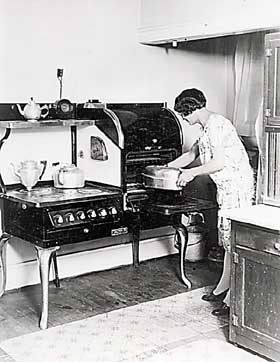
Photo courtesy of South Dakota State
Historical Society
|
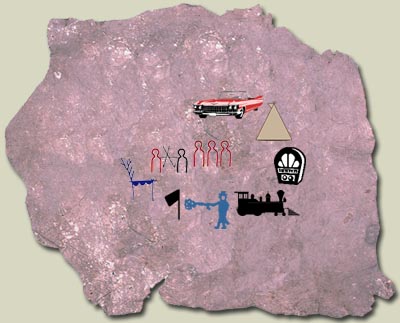
Winter Count
|
|
|
The New Deal
brought hope to many people. A new law gave American Indian tribes the right to set
up their own governments (you read about this in Unit 8). It also
lifted
restrictions on American Indian language and culture.
The Rural Electrification Act (REA) was passed. It helped to bring
electricity to farms and ranches. A new law changed the price of
gold. The Homestake Mining Company grew and did well. It put miners
to work. It put more tax money back into the state.
|
|
|
|
|
Other things
gave people a feeling of hope, as well. Two Army Air Corps pilots
made history in a helium balloon. The men lifted off from the Stratobowl
near Rapid City. Their balloon soared 13.7 miles into the air. They
set a world record and learned more about the air above us. The four
faces of Mount Rushmore were carved. More rain began to fall; there
were fewer grasshoppers. Farmers in the state had a big harvest. The
days of the Dust Bowl were over. Then the Japanese bombed Pearl
Harbor. The date was December 7, 1941. Many Americans died in the
attack. The United States declared war on Japan.
|
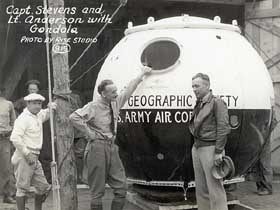
Photo courtesy of South Dakota
State Historical Society
|
|
|
|
|
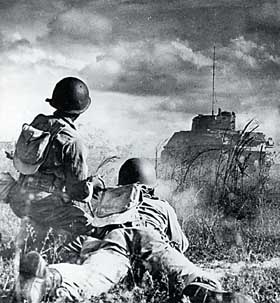
Photo courtesy of South Dakota State
Historical Society
|
Within days,
the United States was also at war with Germany and Italy. The whole
country was now caught up in the Second World War. South Dakotans
lined up to
enlist in the army, navy, marines, and air corps.
Women joined up, too. Many served as nurses, clerks, radio
operators, and pilots. They were in groups like the Women’s Army
Corps (WAC). Some Dakota, Lakota, and Nakota men joined a very special unit. They were
called Sioux code talkers. About ten percent of the people in
South Dakota served in the armed forces. By the end of the war, two
thousand South Dakotans had died.
|
|
|
|
|
The Second
World War changed everyday life in South Dakota, too. Almost
everyone was fighting the war on "the home front."
Schoolchildren collected scrap metal, paper, even bacon grease.
These things could be used to build equipment for the men on the
front lines. Children gathered milkweed pods, which were used as
filling in life jackets. Gasoline, sugar, and meat were
rationed
in South Dakota and across the nation. These things were saved for the men and women fighting the
war. People were urged to grow their own food.
|
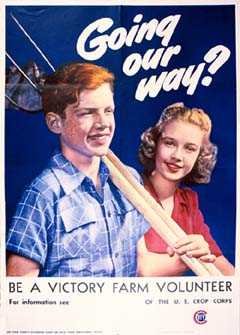
Photo courtesy of South Dakota State
Historical Society
|
|
|
|
|
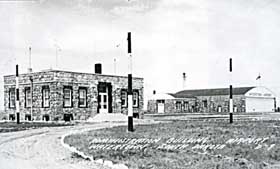
Photo courtesy of Codington County
Historical Society
|
Thousands of
women went to work for the first time. They became factory workers,
truck drivers, carpenters, and so on. The Homestake Mining Company stopped
mining gold. Instead, it made hand grenades and airplane parts. The
Army Air Corps built bases in South Dakota. They were in Sioux
Falls, Watertown, Mitchell, Pierre, and Rapid City. The war itself
came to the state in a small way. Balloon bombs drifted
across the Pacific Ocean from Japan.
|
|
|
Then Germany
surrendered. It was 1945. The United States dropped two atomic bombs
on Japan. The Second World War was over, but the world would never
be the same.
|
|
|
|
| Vocabulary |
|
| enlist (v.), join up; enter into
percentage (n.), a portion of something in one-hundredths
|
rationed (v.), gave out only so much; limited the
amount
restrictions (n.), limits or controls on something
|
|
|